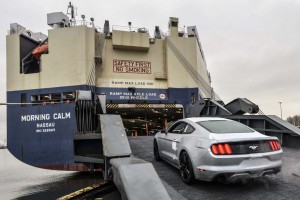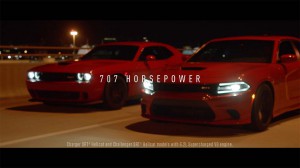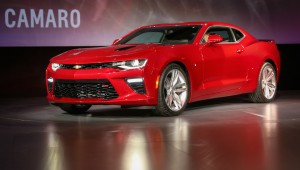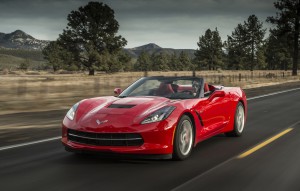At 707 horsepower, the Dodge Challenger and Charger Hellcat models are the most powerful muscle cars to ever roll off a Detroit assembly line, and the fastest. Just ask any dealer who has watched the two vehicles squeal out of showrooms faster than the factory can build them.
Even though Dodge is heavily promoting the Hellcat models in a series of new 30- and 90-second ads, the Hellcats are sold out for the rest of the 2015 model-year. But parent Fiat Chrysler isn’t the only one struggling to meet demand. Ford Motor Co. saw a roughly 40% jump in sales of its long-popular Mustang last month, and while sales are off a bit for the Camaro, Chevrolet expects a big surge of demand once it launches the all-new 2016 version in the months ahead.
Only a few years ago, skeptics were predicting the demise of the muscle car, with the classic V-8 likely to be relegated to the automotive rust heap. Hybrids and battery-cars were expected to take their place. But as recent sales figures have demonstrated, Americans aren’t about to abandon their long-standing passion for performance. These days, manufacturers are being forced to pile on the incentives to get buyers to consider those alternative-power vehicles.
“The love of the Mustang combined with the reintroduction of the Camaro, Challenger and Charger has sparked a resurgence of the muscle car,” said Brad Smith, director of automotive statistics at Experian Automotive, which this week released a new report on the resurgence of American muscle.
(For the first official look at the 2016 Chevrolet Camaro, Click Here.)

The 2015 Ford Mustang is the first of the breed to be sold globally. It'll be offered in 100 markets.
According to Experian, muscle car sales have risen more than 35% over the last nine years and, if anything, there are now more of these vehicles on the road than there have been in decades. After a seven-year gap due to declining sales, Chevrolet took the seemingly risky gamble of reintroducing the Camaro in 2009. It went on to become the segment’s best-seller for five year, only losing its perch as muscle car king-of-the-hill with the launch of Ford’s 50th anniversary Mustang.
“While the growing popularity might run contrary to conventional wisdom, consumers are continuing to show their appreciation for a part of American history and not steering away from raw horsepower to focus solely on fuel efficiency,” Smith said.
That said, even muscle cars are getting better mileage these days. The 455-hp Chevrolet Corvette Stingray can deliver as much as 31 miles per gallon on the highway – a figure that, not that many years ago, would have impressed a compact car buyer.
To get there, manufacturers are using a variety of tricks, such as displacement-on-demand, which shuts off some of an engine’s cylinders when the demand for power is light. Direct injection has the advantage of not only reducing emissions and fuel consumption but boosting performance, as well.
(Ford muscles up the Mustang. Click Here to check out the new Mustang Shelby 350GT.)
Then there are the “blowers.” The 6.2-liter engines in the Dodge Charger and Challenger siblings use supercharging to add scads of power upon demand. The new Mustang, meanwhile, is now offered with a turbocharged engine option for the first time, something that will be offered buyers of the 2016 Chevy Camaro, as well.
Looking forward, as they face even tougher emissions and mileage standards, automakers are looking at still more advanced options. Dave Pericak, the head of the new Ford Performance unit, recently confirmed that the maker is even looking at battery-based technologies, such as hybrids, that could pair performance and fuel economy.
That’s no surprise. Three of the world’s most exotic and powerful supercars, the La Ferrari, the Porsche 918 Spyder and the McLaren P1, all use hybridized powertrains.
With demand so strong, why would Dodge be rolling out a new ad series featuring Phil Collins performing his classic rocker, “In the Air Tonight”?
“We don’t build Hellcats or Vipers for high volume. We build them as brand positioning statements,” explains Dodge CEO Tim Kuniskis. “These vehicles may be a very small percentage of our overall sales but they send a very strong message about the brand personality and attitude.”
That’s particularly important in reaching a new generation of Millennial buyers who, until recently, seemed surprisingly indifferent to automobiles overall. If anything, went conventional wisdom, they were fixated on hybrids and other energy-saving alternatives.
But conventional wisdom has a history of proving wrong. Another study, this one by Enterprise Holdings, found 91% of Gen-Y stating it is “important” to own a car. Meanwhile, Ford reports that 35% of Mustang buyers nationwide are Millennials, a figure that climbs to 40% in California.
Not surprisingly, industry data show that demand for performance cars tends to be stronger in Sunbelt regions of the country. According to the Experian study, Texas residents were, on a per capita basis, 79% more likely to buy a muscle car than motorists in Vermont.
(Click Here for more on the Experian muscle car study.)




Many people can rationalize driving a modern muscle car as it offers acceptable everyday driving comfort and acceptable fuel economy unlike in the early seventies when both insurance rates and fuel costs unfairly skyrocketed due to pure financial greed.
In addition many people have come to understand that muscle cars may once again be endanger species with the outrageous Obama/EPA 54.5 mpg CAFE decree. The gas guzzler taxes will kill these well engineered, fuel efficient cars in favor of impractical, unrealistic EVs that will prove very costly to the environment via toxic waste and to consumer’s wallets. Tax payers will pay for the entire mess…They always do.
your an idiot. EV’s are the future.
Not necessarily. If you look back at the era when cars were just starting out, they weren’t sure at that time either which fuel would power the future of vehicles. You had electric vehicles then, the diesel was originally designed for vegetable based (renewable) oils, steam cars were around then too. However, ‘rock oil’, as they called crude then turned out to be cheap enough that the fleets, (work vehicles, city bus lines, truck transport), used it over any of the others and guess which fuel won? Well think about your local bus fleets and what a lot of truck lines and fleet vehicles manufacturers are getting into now. I’ll give you a hint, it’s not electric. Its Natural gas and propane. Guess which fuel will probably win this round of ‘which fuel will it be’?
This isn’t the first time the Mustang has been offered with a turbocharged engine…Mustang SVO came with a turbocharged / intercooled 4-cylinder w/ T5 transmission.
This same engine/trans combo was used in the T-Bird Turbo Coupe. I don’t believe the Fox-Body stable mate Mercury Cougar received it, can’t remember if the Capri got that drivetrain either but then it went FWD anyway.
To be precise, a special Mustang version was offered with a turbo for a brief time. This is the first time a mainstream Mustang has gone turbo.
Paul E.
Before the SVO Mustangs of the mid 80’s you could but a 2.3 liter turbo Mustang. I believe the first year was 1980. This was not considered a “special model”.
Jorge,
Isn’t the 54.5 CAFE, just like all of the previous and current rulings, based on the CORPORATE fleet average, not just certain vehicle groups? There are plenty of vehicles in these organizations that can make the 54.5. Also, each of these “muscle cars” have bread and butter models as well. And just like the old days, the high-power versions always make the headlines but their 4- and 6-cyl main models are the majority of the ones that sell.
The gas guzzler taxes haven’t killed the likes of the higher-end (and higher costing) MBs, AMs, JLRs and the like.
Pretty much right across the board. This is a fleet average and there’s a formula for each vehicle class, ie full-size pickups don’t actually need deliver the same mileage as a subcompact. Meanwhile, there are credits for all the adjustments made over the years to testing procedures, etc., which means the real-world numbers are closer to the low-mid-40 mpg range, anyway. And there will be credits for certain others things the makers do, as well, ie certain ZEV or PZEV systems get additional credits, as has been the case for vehicles qualified as “bi-fuel.”
Paul A. Eisenstein
Publisher, TheDetroitBureau.com
People buying expensive Porsche, Audi, BMW, M-B, etc. are not going to be deterred over a gas guzzler fee. Unfortunately the fines that will be applied for not meeting the 54.5 mpg CAFE will apply to all models sold, not just to the models that do not meet the 54.5 mpg CAFE requirement. That means every model from an entry level $15K car to the most expensive model could be hit with a $3-4-5,000 fine added to the sticker price. The bottom line is consumers get screwed over big time by the politicians in DC. Studies have shown that many people will be shut out of the new car market completely due to the dramatic vehicle cost increase and the fines.
No the 54.5 mpg CAFE deal is far more stringent than past requirements. My understanding is that the plan is to impose a fine on all corporate models if the auto maker does not meet the 54.5 mpg CAFE. That would mean every car model/consumer gets fined not just the models that don’t meet the absurd 54.5 mpg CAFE requirement.
I think it’s just the fact that people are tired of cheezy, wimpy, ugly, plain cars. We all want to save money on gas. But, if that means driving a car with no pizzaz, nothing exciting, boring style and “everybodies car looks like this” appearence, then people will gladly pay more for gas to avoid these vehicles. Americans love their cars. They always have. This resergence of 70’s style muscle cars is the perfect example. You are also seeing far more full sized pickup trucks on the road. Not mid-size or economy, but full size, big engines, and lots of power, just like the cars! So you can keep your prius, leaf, and volt. Real drivers will be blowing by you in their Cameros, Challengers, and Mustangs. Yea, we’ll stop more often to fill-up, but we’re laughing at you as you putter on by in that weenee hybrid!! AMERICAN MUSCLE ROCKS!!